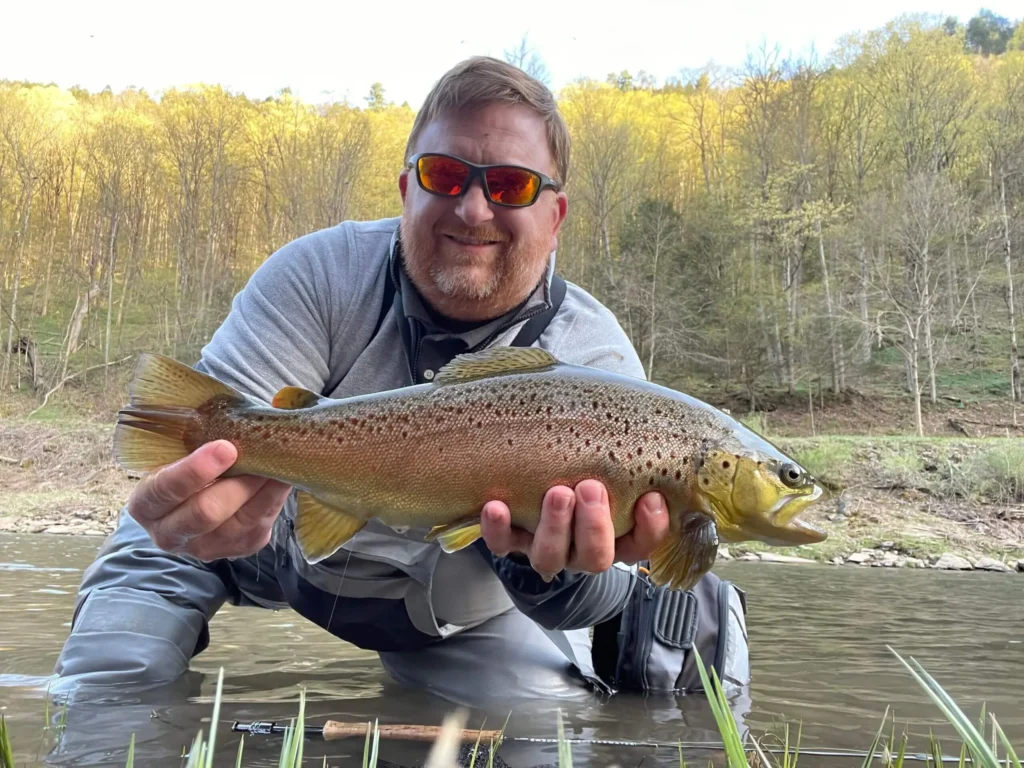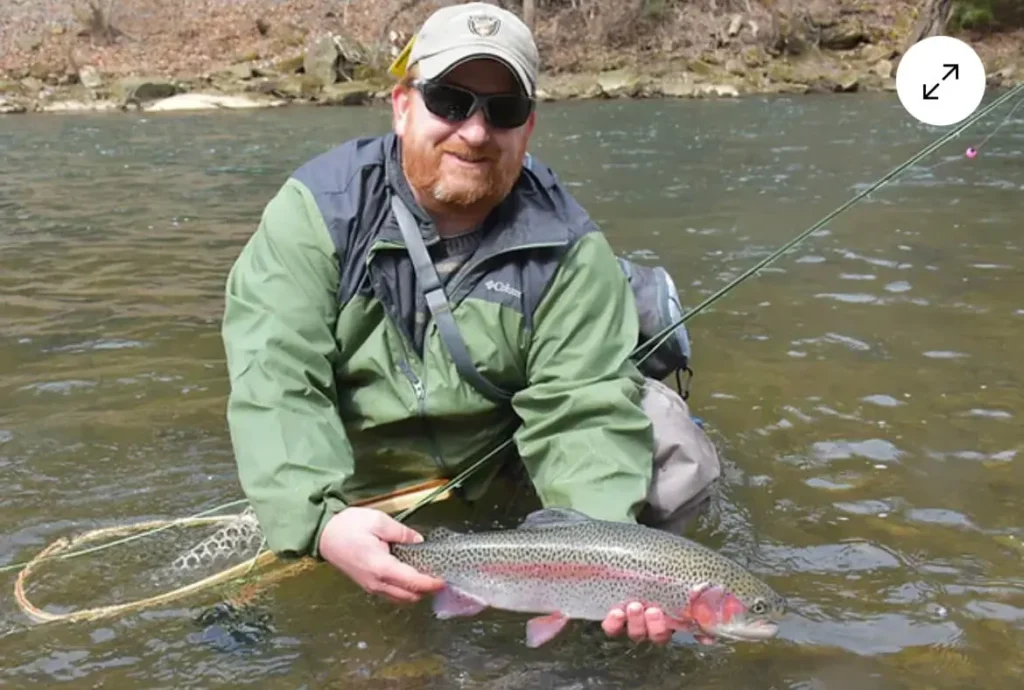After the Strike: 3 Keys to Landing Big Trout

You’ve spotted a big fish, made the perfect drift that put the fly right on its nose, and incredibly, the giant’s mouth flexes as it inhales your presentation. Fish on! Now what?
It’s during these first few seconds of the fight that I start wondering…what X tippet do I have on again? When was the last time I retied the knot? And a whole host of worries!
Hopefully you have the right terminal tackle to handle the situation, but if not, you’ll soon find out. Besides, whether you’re using 4x or 6x tippet is irrelevant, in my experience, because fish are seldom lost simply because your gear is too light. I’ve landed some amazing wild browns on 5x and 6x tippets, and I’ve lost just as many on 3x and 4x. Often, it comes down to the decisions you make during the battle that determine whether or not you’ll ultimately land that fish.
During any battle with a big trout (with any large specimen of any species), you’ll encounter factors that are within your control as well as those that are outside of your control. Examples of things outside of your control would be how well the fish is actually hooked and in-water structure (rocks, logs, etc.) that the fish can get wrapped around.
But there are several things within your control that can make a huge difference during the course of any skirmish with a freaky big trout. Three keys that I’ve found are when and how to use side pressure, knowing when to let the fish run, and knowing when the time is right to apply more pressure and bring that trophy to net.

1. Use Side Pressure
A key mistake anglers make is holding their rod high while playing a large trout. However, when the fish comes to the surface shaking its head, the angle of the rod and line often pulls the fly right out of the fish’s mouth.
Big fish are very good at using their weight to their advantage. They’ll often thrash at the surface and twist their bodies to simply power off the hook. A high rod tip encourages the fish to fight at the surface rather than deeper in the water column. Applying side pressure will negate some of these effects and the trout will be less likely to break the water’s surface and/or roll.
Side pressure is achieved by holding your rod tip down, almost parallel to the water’s surface. Feeling this pressure will cause the fish to fight deeper rather than come to the surface.
Also, side pressure allows more of your line to stay in the water, which provides more tension and a tighter connection to the fish. In essence, the trout feels not just the stiffness of the fly rod but also the power of the current pulling the line tight, and the fish will tire faster.
When holding your rod tip high, a longer section of line is in the air, and that line will vibrate and shake in reaction to what the fish is doing down below. Every time the line moves, it creates slack, and you lose connection with the fish, which can allow your fly to pop loose. This is especially important to consider if using barbless hooks! Side pressure will help keep that barbless hook buried in the fish’s jaw.
Another thing to consider with side pressure is to maintain a “quiet rod” throughout the battle. I often see anglers hook a big fish, correctly use side pressure, but they change sides, shifting their rod tip from one side of their body to the other as they fight the fish. Whenever possible, fight the fish from one side of your body while it’s out in front of you. Moving your rod from one side to the other changes the angle of your line, therefore changing the way the fly is hooked in the fish’s mouth. Only shift rod position once you know on which side you’ll ultimately want to land the fish.

2. Let Them Run When They Want to Run
You can get away with horsing in a small fish, stopping them mid-run and forcing them back to the net. Not so with bigger, heavier fish. You have to let them run, even if it means letting them take you into your backing or heading downstream.
Inevitably, at some point during the battle, a big fish is going to make a hard run downstream. This is true in fast current as well as in slower currents. They instinctually want to run directly away from whatever has hooked them. Trying to stop them typically results in broken lines, busted tackle, or even just hooks pulled out of the fish’s mouth.
I can’t even count how many times I’ve landed a great wild brown and noticed that my hook was barely attached to the thinnest of skin on its top lip. If at any point I had applied too much pressure during the fight, the hook would have ripped right out.
While guiding, when clients have hooked into large trout, one of the first things I tell them is that if the trout wants to run, let it run. Unfortunately, they seldom heed my advice. Several times this year, clients hooked fish right at the tailouts of long pools, right before some heavy riffles, and they didn’t want the fish to get into those riffles and be washed downstream. So they tried to hold the fish in the pool, and the line inevitably snapped.
How aggressive you should be with this depends on your mobility and physical condition. If you’re simply unable to quickly wade to shore and follow the trout downstream, then you really don’t have a choice and have to try to turn it. If possible, though, follow the fish to the fast water below. The fish will stop; it won’t run forever. And as you’re following it downstream, try to guide the behemoth toward shore with side pressure. Usually within just a few yards, I’ve caught up with the fish and had it corralled in the calmer bank water, even along stretches with very heavy, deep current.
The key to remember here is to maintain side pressure as you follow the fish downstream. Doing this will coax the fish toward the bank to a point where you’ll be able to easily intercept and net the beast.
3. Know When and How Hard to Apply Pressure

The longer you fight a fish, the greater the odds of it getting off. A major key to landing freaky big trout is to know exactly how much you can pressure the fish without pushing the limits of your tackle. In this case, it helps to know a little bit about trout biology.
Trout prefer to face into the current when hooked. This keeps water pumping through their gills, essentially allowing them to breathe. Side pressure can help turn their head out of the current, basically cutting off their oxygen supply. After a fish has made its big run downstream – and assuming you survive that part of the battle – once it begins to tire and you start to notice the fish cannot maintain its position facing directly into the current, that’s when you should put a little extra power into coaxing the fish to the net.
Where many anglers go wrong is that they’re simply afraid to put ANY pressure on the fish. They play it needlessly long. In essence, they start to tire out the fish but then allow it to recover in the current because they fail to recognize that moment when they can apply more power and get the trout landed.
Last summer (2023), I caught the biggest wild brown trout of my life, a stud of a fish on a fairly large river. I was wading in waist-deep water when I hooked the fish. Upon hooking the trout on a quartering downstream drift, I brought it upstream toward my position. The fish then took a long run downriver. I followed it, slowly wading downstream, letting the fish take me almost to my backing.
But as I waded downstream, I reeled up line, and the fish turned and came back toward me. It swam upstream, fighting hard. At one point, I brought the fish even with my position out from the bank and then brought it down to me. The fish dodged the net and headed back out into the current. Rather than letting it take another run, I applied heavy pressure – almost to the 5x tippet’s breaking point – and got the fish to turn back toward me and toward the bank. Once I had it coming, I lifted my rod, which brought the fish to the surface, and I was able to skate it right into the mouth of the net.
Too many times, after missing with their first netting attempt, I’ve seen anglers allow the fish to run again or sit out in the current. When this happens, the fish is literally catching its breath and regaining energy. And the fight continues. And often ends in heartbreak.
Also consider that the quicker you land a fish, the better its chances for recovery and survival. If you’re spending too much time trying to revive fish, then you’ve likely played it longer than necessary, and that trout’s odds of survival hours and even days later are much lower.
Conclusion
Sadly, the best way to get better at landing big fish is to lose a lot of them. And I have lost perhaps more than my share. I used to lie awake at night wondering if I’d ever be lucky enough to land a giant wild brown. It seemed like God or magic or some kind of voodoo had to be involved for everything to go right and make that trout mine.
But the real answer was experience. I had to figure it out. Once I understood the principles of side pressure and rod angle, once I became more patient and allowed the fish to take its big run, and once I knew when it was time to finally get serious and apply enough pressure to tire out and land the fish, my success rates on big trout significantly increased.
I still lose fish. We all do. Sometimes it’s just not meant to be. Something happens that’s out of our control. But when you’ve mastered the techniques listed here, you’ll be more effective at managing the factors that are within your control, and you’ll inevitably start landing more big fish than you lose.
Looking to take your fishing to the next level?
Book a day on the water where we can show you how to read the water, make better presentations, catch more fish, and enjoy time spent outdoors more than ever before.
Book Now!Did You Find This Article Helpful?
Stay up to date with the Dark Skies Fly Fishing monthly newsletter for free and receive the latest posts in fly fishing news, tricks, tips, and techniques, stream reports, as well as updates on new flies added to the Online Store and exclusive discounts!
Sign Up Now
